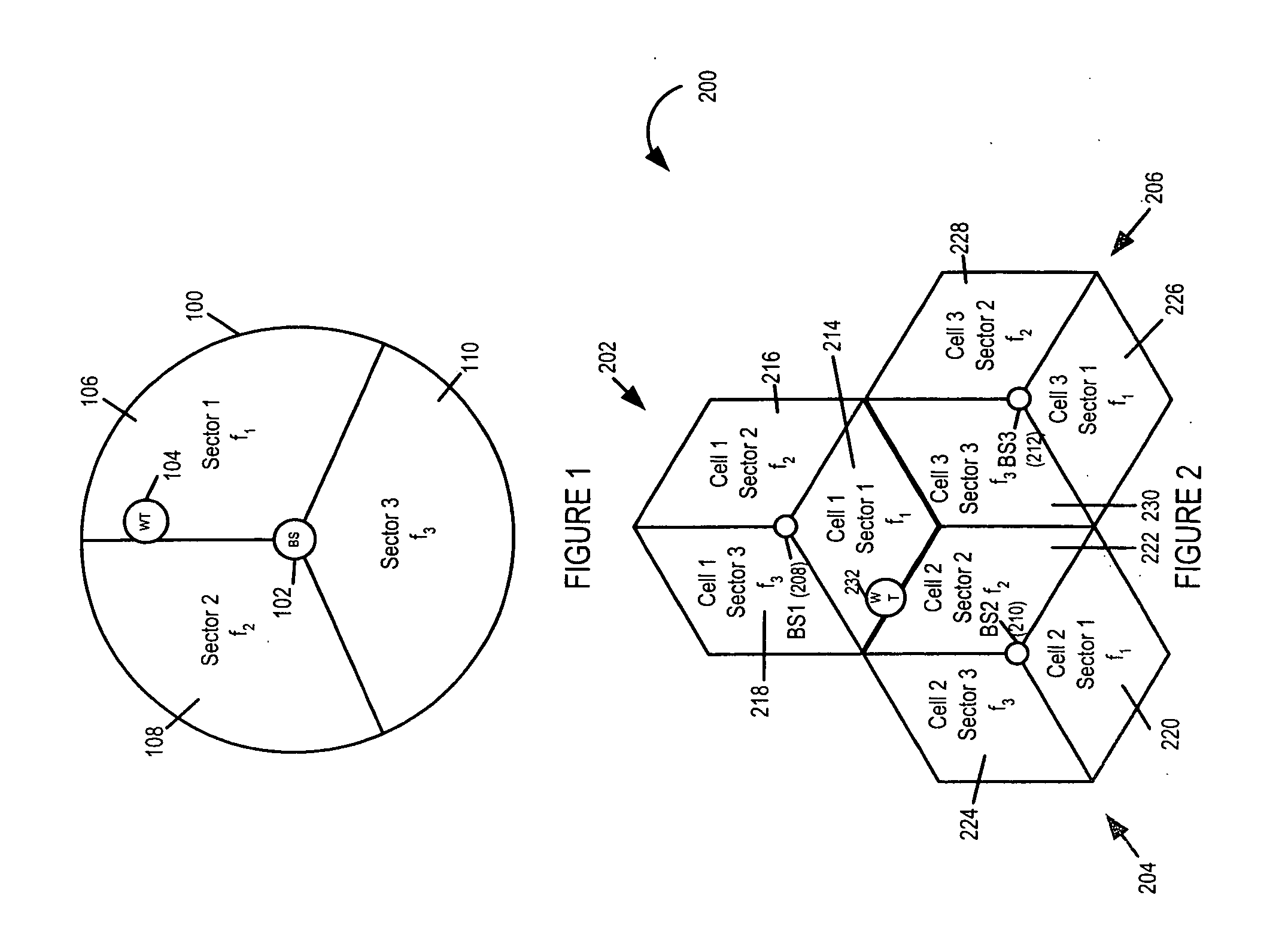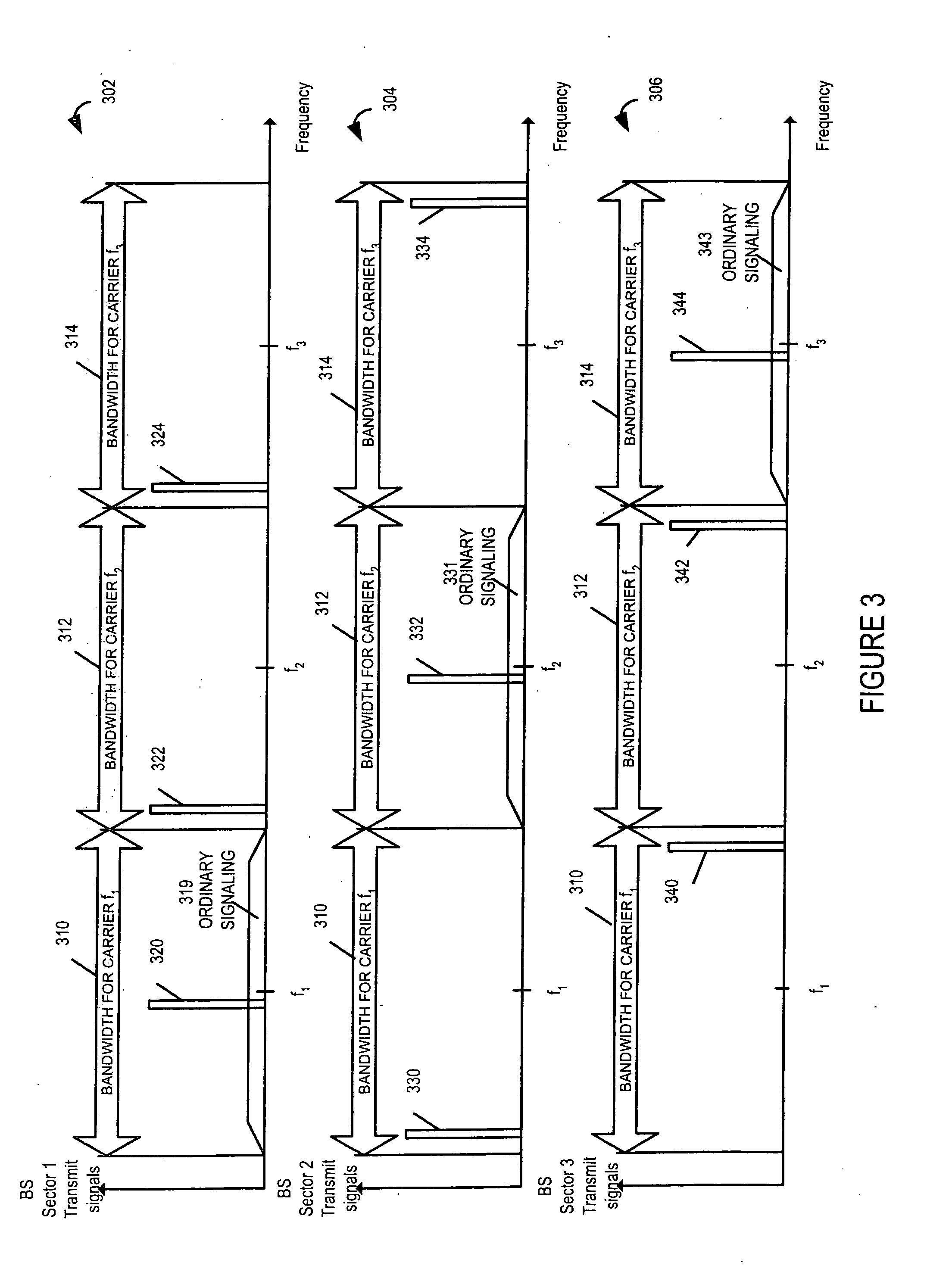[0019] In accordance with the present invention handoff operations are initiated by a wireless terminal, e.g., a mobile communications device, via a current base
station sector with which the mobile device has a wireless communication connection, e.g., a first communications link implemented using a first carrier frequency. The mobile device communicates via the first communications link and the current base
station sector its desire to complete a handoff to a different base
station, sector, or carrier within the sector in which the mobile device is located. The new communications link will be established using a new carrier frequency which will often be different from the first carrier frequency. The base station sector with which the new communications link is to be established, referred to as the new base station sector, assigns to the mobile device, via the current base station sector and the first communications link, one or more airlink related resources to be used upon entry into the new base station sector or upon switching to the new carrier frequency within the current sector when the new base station sector is the same as the current base station sector. The airlink related resources may be one or more
device identifiers (such as MAC state identifiers, e.g., ON state identifier,
ACTIVE state identifier) which are to be used when communicating in the new base station sector using the new carrier frequency. As part of the handoff process the new base station sector may dedicate and thereby reserve physical signaling resources, associated with the new carrier frequency, for use by the mobile device initiating the handoff operation, e.g., dedicated communications bandwidth such as, e.g., a set of tones, to be used to complete the registration process upon entry into the cell using the new carrier frequency. The dedicated set of tones may be used, e.g., for
power control and / or timing control operations upon entry into the new base station sector. Such dedicated resources may be allocated within a periodically occurring access or registration time period. The new base station sector communicates, in some embodiments, information identifying the particular registration period in which the mobile was allocated the dedicated resources. This information is used, in various embodiments, to determine when the current communications link with the current base station sector should be terminated and a new communications link using the new carrier should be established with the new base station sector, so that the disruption of services due to the termination of the first communications link can be minimized.
[0020] After making a decision to initiate a handoff operation, the mobile node and / or current base station sector sends an IP routing update message to a mobility agent, e.g.,
Mobile IP home agent, used to redirect IP packets intended for the mobile device to the base station sector being used to attach the mobile device to the network. The IP routing message causes the mobility agent to begin redirecting IP packets intended for the mobile device to the new base station sector to which the handoff is to be completed. In some embodiments, the transmission of the IP routing update message is sent after receiving a device identifier to be used in the new base station sector and / or dedicated resources to be used in the new base station sector, e.g., to complete a registration process. This ensures that the new base station sector has resources available to service the mobile device seeking to complete the handoff to the new base station sector.
[0021] In the above described manner, a mobile node can initiate a handoff to a new base station, sector or carrier within a sector involving a change to a different carrier frequency via its existing communications link. In this manner, the need to tune to the new carrier frequency to begin the establishment of a connection using the new carrier frequency can be avoided and the mobile node can receive resource assignments corresponding to the new base station, sector and / or carrier frequency without having to first switch to the new carrier frequency. Resources assigned by the new base station or sector may include, e.g., a sector specific and / or sector carrier specific device identifier to be used when communicating in the new sector and / or using the new carrier frequency. Dedicated communication segments for establishing the communication signaling, e.g., power, timing control, and / or registration signaling, may also be assigned by the new basestation and / or sector with the assignment being communicated over the first communications link to the mobile node before establishing signaling over the new communications link using the new carrier frequency.
[0023] In the case of single sector cells, handoffs between old and new base stations correspond to handoffs between base stations of different cells due to the one to one relationship between cells and base station sectors. However, in the case of multi-sector cell implementations, intra-cell inter-sector handoffs are possible with the old and new sectors being in the same cell. In some embodiments, in intra-cell inter-sector handoffs, timing synchronization is maintained between the base station sectors, and the timing synchronization steps, normally performed, in a handoff process are omitted. In such cases, a handoff to a new sector of the same cell can be completed without a timing synchronization operation being performed. Thus, upon entering the new sector, following termination of the old communications link, the mobile device can begin transmitting user data prior to receiving a timing
synchronization signal from the base station or performing a timing synchronization operation. This is because timing synchronization between sectors of the cell is maintained in some embodiments and relying on the timing synchronization initially achieved in one sector of a cell is not likely to cause interference problems in the other synchronized sector of the same cell. Skipping an initial timing synchronization step, which is normally required upon entry into a new cell, when implementing an intra-cell handoff, reduces delays associated with implementing intra-cell handoffs as opposed to inter-cell handoffs.
[0024] While the method and apparatus of the present invention still involve breaking radio communication over an existing communications link implemented using a first carrier frequency, prior to establishing radio communication using a second, e.g., different, carrier frequency, the signaling exchanged prior to this operation by way of the existing communications link which uses the first carrier frequency allows the mobile device to obtain some of the benefits of a make before break handoff, e.g., ID assignments and airlink resource allocations, prior to actually breaking communication over an existing link thereby reducing the latency and uncertainty associated with many make before break handoff operations.
 Login to View More
Login to View More  Login to View More
Login to View More 


